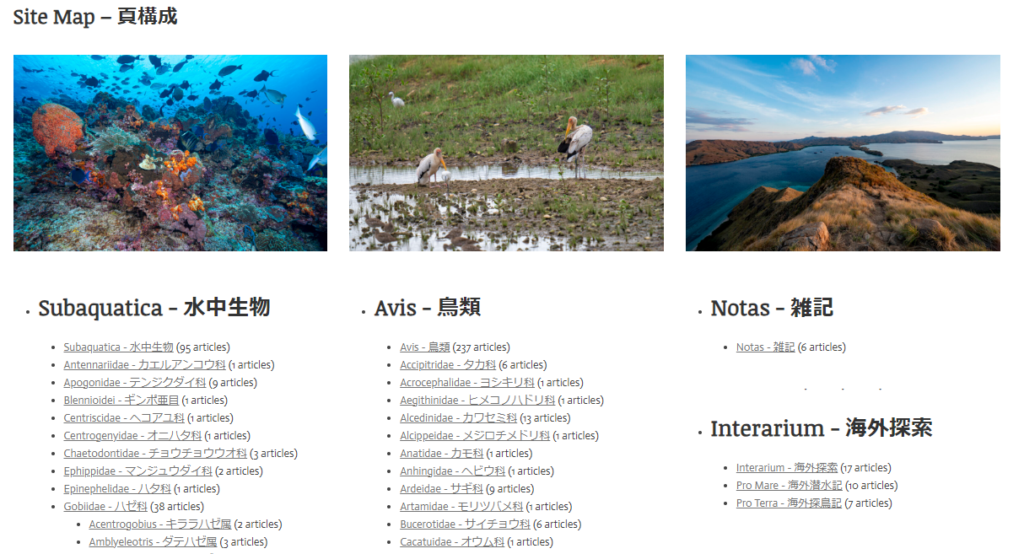Our site is designed for the use as a field guide, incorporating various features to enable searches from different perspectives. Therefore, on this page, I would like to introduce four tips. By extracting information more effectively, I hope users can discover deeper connections and surprises in nature.
当サイトは図鑑的に使用していただくことを前提に、様々な側面から検索をかけられるように工夫が施してあります。そこで本頁において4つのTipsを紹介したいと思います。より効果的に情報を引き出すことで、一層自然の奥深い繋がりや驚きを発見していただければ、存外の喜びに存じます。
1. Free Search – 自由検索

When you click ![]() on the menu bar of the top page, a search window will appear. You can index articles by entering any keyword, including species names. It functions like a search engine, allowing for the most intuitive searches. However, since every word in the articles is searchable, it may not be suitable for structured indexing.
on the menu bar of the top page, a search window will appear. You can index articles by entering any keyword, including species names. It functions like a search engine, allowing for the most intuitive searches. However, since every word in the articles is searchable, it may not be suitable for structured indexing.
当サイトのトップページのメニュバーの![]() を押下いただくと、検索ウィンドウが現れます。種名を含むあらゆるキーワードの入力により記事の索引が可能です。検索エンジンのようにして、最も直感的な検索が可能である一方、記事の中のあらゆる語が検索の対象ですので、体系立てた一覧の索引には不向きです。
を押下いただくと、検索ウィンドウが現れます。種名を含むあらゆるキーワードの入力により記事の索引が可能です。検索エンジンのようにして、最も直感的な検索が可能である一方、記事の中のあらゆる語が検索の対象ですので、体系立てた一覧の索引には不向きです。
2. Menu Bar – メニューバー

The menu bar on the top page allows for categorization into “PISCIS – 魚” and “AVIS – 鳥”, along with the option to drill down by region.
This site follows the principle of one species per page. Therefore, if a species is observed in multiple countries, I consolidate the observation information for each region within the same article without splitting it.
As of April 2024, only observations from Singapore are published for fish, so there are no regional divisions.
トップページのメニューバーは、「PISCIS – 魚」と「AVIS – 鳥」の区分けに加えて、地域別にドリルダウンすることが可能です。ちなみに、当サイトは1種1頁を原則としていますので、複数国で観察された場合は、記事を分割せずに同一記事に各地域での観察情報を纏めて掲載しています。なお、2024年4月現在、魚類はシンガポールでの観察事例のみを掲載してますので、地域別の区分はありません。
3. Family Name – 科名検索


Please try accessing the Site Map from the menu bar. There, you’ll find a list of family names, allowing you to index a list of species belonging to a specific family. This is useful when you want to comprehensively index species belonging to a particular family. As an exception, for the family of fish called gobies, we also classify them by genus.
The numbers following each family represent the number of articles, meaning the number of observed species. This is because we follow the principle of one species per article.
MenuバーからはSite Mapにアクセスしてみてください。そこでは科名の一覧を掲載しており、例えば当該科に属する種の一覧を索引することが可能です。特定の科に属する種を網羅的に索引したい場合に便利です。例外として魚類のハゼ科については属による分類も行っています。
各科の後に続く数字は記事数を表していますが、それはすなわち観察した種数を意味します。1種1記事を原則としているためです。
4. Tag – タグによる分類

At the end of each article, a list of tags is provided. These tags are prepared as slicers for the classification of fish or bird, family names, and observation locations. For example, when you’re referencing a particular species and want to investigate what other species belong to the same family, you can easily index a list of relevant species by clicking on the family name tag.
各記事の末尾にはタグの一覧が掲載されています。タグは、魚類か鳥類の分類、科名、観察地をスライサーとして用意しており、情報を整理するようにしています。例えば、ある種を参照していて、当該種が属する科には、どのような種が他にもいるのだろうか?といったことを調べたいとき、科名のタグをクリックしていただくことで、該当する種の一覧を索引することが容易に可能となっています。